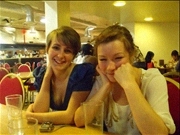Tutor HuntResources English Resources
Questioning Realism In The Jabberwocky, Fight Club And Midnight`s Children
An excerpt from a 2nd Year Critical Theory essay, graded at 72
Date : 15/07/2013
Author Information

Uploaded by : Bethany
Uploaded on : 15/07/2013
Subject : English
In the course of this essay, I will focus on texts that fit into the cast of modernism, here referring to a problematision at the level of content, as defined by Lyotard. I have decided to examine a range of texts, which fall under the umbrella of "best sellers", chosen for their demonstration of different disruptive flickers in the popular realist mode. I wish to demonstrate that although classic realism is by far the most popular literary mode, its problematisation is in no way restricted to academic or peripheral texts. My chosen texts are not typical of the moniker `postmodern` but instead justify my argument that popular authors are deliberately attempting to disrupt classic realism, not through the complete overturning of the mode but through momentary disruptions. The texts reveal their fictionality in a way which forces readers to abandon a position of dominant specularity without disrupting the reading experience. It is my belief that "true" postmodern texts, defined by Lyotard as having `no concern for the unity of the whole`, such as James Joyce`s Finnegans Wake, will never succeed in problematising realism for the masses as they fail to function as readable units of literature.
Paul Cézanne`s Grounds of the Château Noir, a distorted painting which captures a woodland scene, is an attempt by a modernist artist to draw attention to the act of creating a fiction. Although the subject matter is clear, the visual is distorted and so the image does not present a fixed central truth. In Lewis Carroll`s Jabberwocky (see Appendix I), a similar act of literary distortion occurs and although I will go on to examine the works of contemporary authors, I feel it is first necessary to demonstrate that the movement to undermine realism occupies no fixed time period, as Lyotard states in his essay `Answer to the Question: What is the Postmodern`. Carroll`s nineteenth century Nonsense poem uses an imagined set of nonsense words and neologisms to draw attention to its fictionality and to deny readers a position of dominant specularity in which the poem holds one truth. This reflects the postmodernist`s desire to disrupt depth models, which, is to say the idea of a truth behind façade. The achievement of Jabberwocky is not the presentation of a code to be cracked, but in Carroll`s ability to coin words that are understandable despite bypassing conventional rules of language change. Instead of being transmitted through the S curve or wave model, Carroll creates his own idiolect which then is culturally transmitted to become a sociolect without defining his neologisms and without first achieving the consensus of a community. He successfully coins polysemic words by following the rules of English language construction. `Mimsey` is made up of existing English sound units which allows the reader to accept the adjective as a pre-existing word. In the same way that readers do not question the validity of a word they have never come across, so Carroll`s nonsense poem, by building up nonsense words that are redefined by each successive reader, allows readers to fill the gaps left for the unpresentable and create their own meanings. Carroll`s jubilant and excessive polysemia refuses to allow for an absolute and central truth. He forgoes his Authority and despite dictating the plot of the poem, reduces the metalanguage to the level of nonsensical neologisms which lack an authoritative definition, and thus, the metalanguage itself is left open for interpretation. Carroll commits to an act of decentring. He challenges the logo-centric nature of realism by refusing to acknowledge a final meaning. Although, at the level of form, the poem does not problematise realism, the act of repeating the first and final stanza, a common attribute of Nonsense literature, denies the poem an ending as it circles infinitely. Carroll also conforms to Lyotardian ideas of the sublime. His nonsense words are mostly adjectives and nouns and by refusing to commit to descri ptions of his landscape or his creatures, he comes into agreement with Lyotard, when the theorist writes `it is not up to us to provide reality, but to invent allusions to what is conceivable but not presentable`. Carroll, like Cézanne, refuses to fabricate an empirical truth based on the evidence of his eyes. Carroll`s poem, therefore, is an early example of the ways in which realism can be problematised yet retains what I believe is central to its status as literature - its readability.
This resource was uploaded by: Bethany
Other articles by this author
- Surviving Death in Arundhati Roy`s `The God of Small Things` and Michael Ondaatje`s `Anil`s Ghost`
- To what extent do you agree that Ferdinand and Isabella laid the foundations for a Spanish Golden Ag
- Clactononsea
